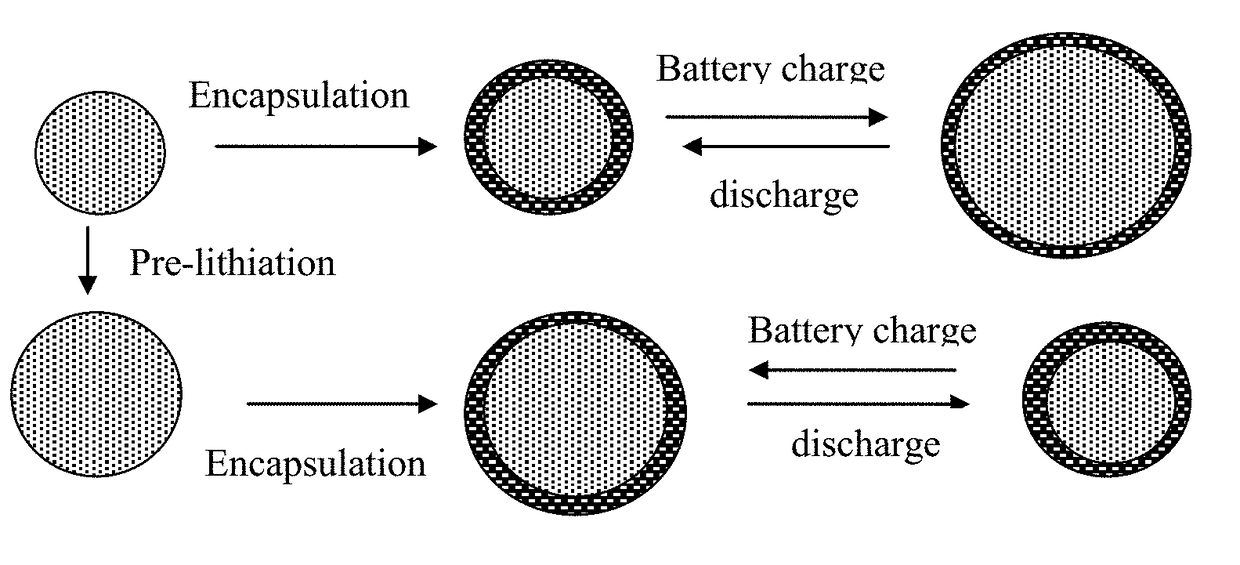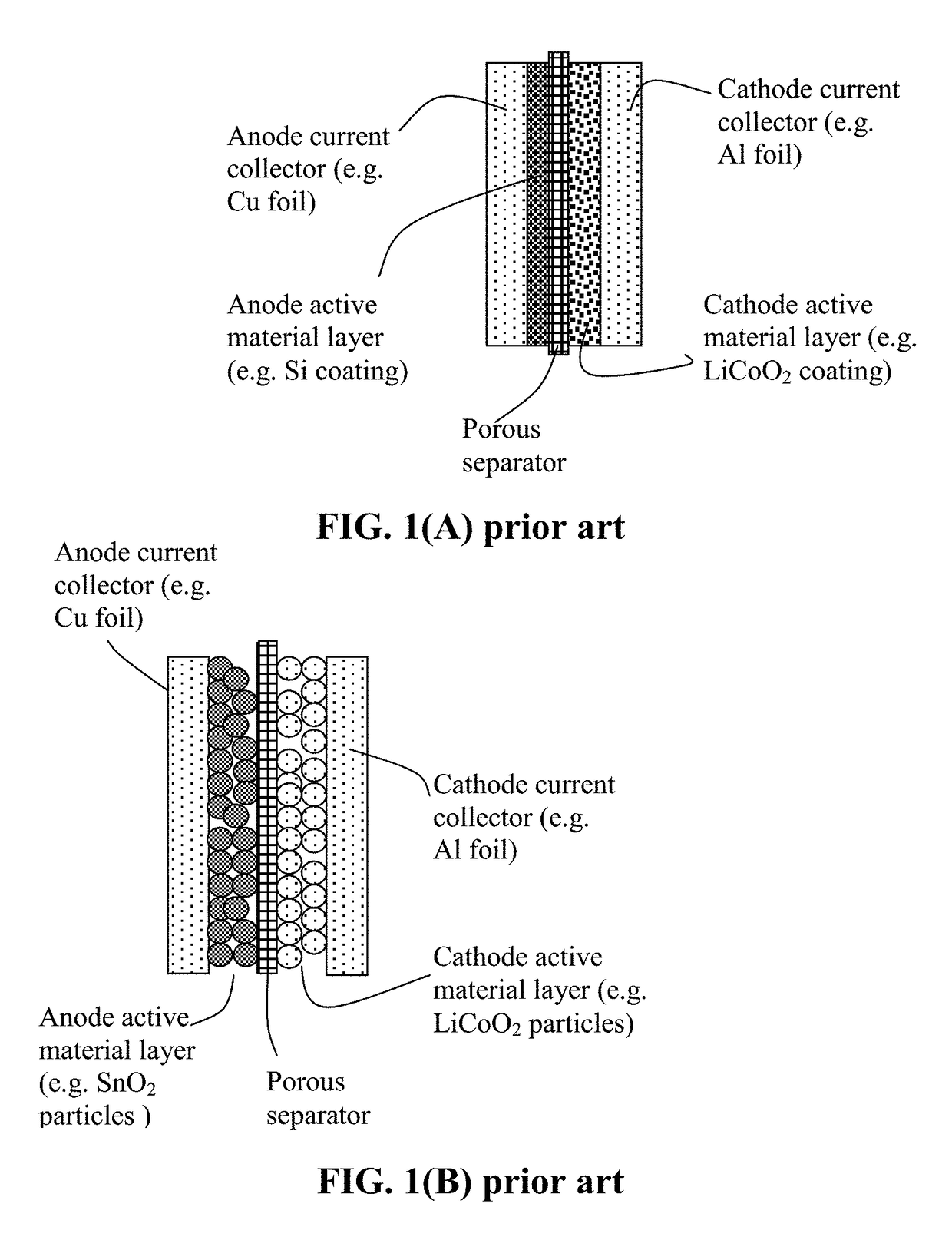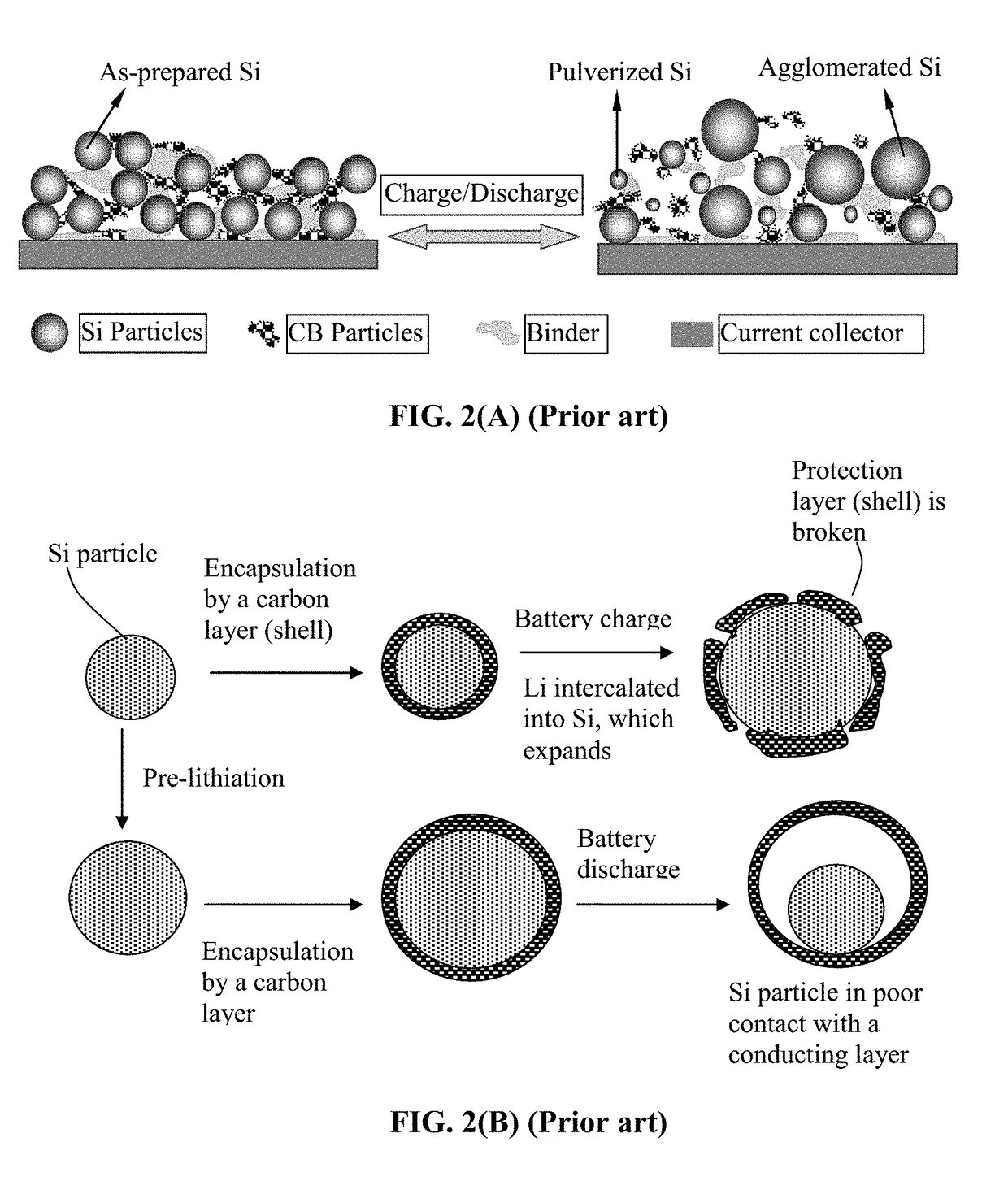Lithium Secondary Batteries Containing Protected Particles of Anode Active Materials and Method of Manufacturing
a lithium battery and active material technology, applied in secondary cells, fuel and other directions, can solve the problems of severe pulverization (fragmentation of alloy particles), loss of contacts between active material particles and conductive additives, etc., to improve lithium ion conductivity to a polymer
- Summary
- Abstract
- Description
- Claims
- Application Information
AI Technical Summary
Benefits of technology
Problems solved by technology
Method used
Image
Examples
example 1
High-Elasticity Polymer-Protected Cobalt Oxide (Co3O4) Anode Particulates
[0116]An appropriate amount of inorganic salts Co(NO3)2·6H2O and ammonia solution (NH3·H2O, 25 wt. %) were mixed together. The resulting suspension was stirred for several hours under an argon flow to ensure a complete reaction. The obtained Co(OH)2 precursor suspension was calcined at 450° C. in air for 2 h to form particles of the layered Co3O4. Portion of the Co3O4 particles was then encapsulated with an ETPTA-based high-elasticity polymer according to the following procedure:
[0117]The ethoxylated trimethylopropane triacrylate monomer (ETPTA, Mw=428, Sigma-Aldrich) was dissolved in a solvent mixture of ethylene carbonate (EC) / diethyl carbonate (DEC), at a weight-based composition ratios of the ETPTA / solvent of 3 / 97 (w / w). Subsequently, benzoyl peroxide (BPO, 1.0 wt. % relative to the ETPTA content) was added as a radical initiator to allow for thermal crosslinking reaction after mixing with anode particles. ...
example 2
High-Elasticity Polymer-Encapsulated Tin Oxide Particulates
[0125]Tin oxide (SnO2) nano particles were obtained by the controlled hydrolysis of SnCl4·5H2O with NaOH using the following procedure: SnCl4·5H2O (0.95 g, 2.7 m-mol) and NaOH (0.212 g, 5.3 m-mol) were dissolved in 50 mL of distilled water each. The NaOH solution was added drop-wise under vigorous stirring to the tin chloride solution at a rate of 1 mL / min. This solution was homogenized by sonication for 5 m in. Subsequently, the resulting hydrosol was reacted with H2SO4. To this mixed solution, few drops of 0.1 M of H2SO4 were added to flocculate the product. The precipitated solid was collected by centrifugation, washed with water and ethanol, and dried in vacuum. The dried product was heat-treated at 400° C. for 2 h under Ar atmosphere.
[0126]The high-elasticity polymer for encapsulation of SnO2 nano particles was based on cationic polymerization and cross-linking of the cyanoethyl polyvinyl alcohol (PVA-CN) in succinonitr...
example 3
Tin (Sn) Nano Particles Encapsulated by a PETEA-Based High-Elasticity Polymer
[0129]For encapsulation of Sn nano particles, pentaerythritol tetraacrylate (PETEA), Formula 3, was used as a monomer:
[0130]The precursor solution was composed of 1.5 wt. % PETEA (C17H20O8) monomer and 0.1 wt. % azodiisobutyronitrile (AIBN,C8H12N4) initiator dissolved in a solvent mixture of 1,2-dioxolane (DOL) / dimethoxymethane(DME)(1:1 by volume). Nano particles (76 nm in diameter) of Sn were added into the precursor solution and were encapsulated with a thin layer of PETEA / AIBN / solvent precursor solution via the spray-drying method (some solvent evaporated, but some remained). The precursor solution was polymerized and cured at 70° C. for half an hour to obtain particulates composed of high-elasticity polymer-encapsulated particles.
[0131]The reacting mass, PETEA / AIBN (without Sn particles), was cast onto a glass surface to form several films which were polymerized and cured to obtain cross-linked polymers...
PUM
| Property | Measurement | Unit |
|---|---|---|
| thickness | aaaaa | aaaaa |
| lithium ion conductivity | aaaaa | aaaaa |
| tensile strain | aaaaa | aaaaa |
Abstract
Description
Claims
Application Information
 Login to View More
Login to View More - R&D
- Intellectual Property
- Life Sciences
- Materials
- Tech Scout
- Unparalleled Data Quality
- Higher Quality Content
- 60% Fewer Hallucinations
Browse by: Latest US Patents, China's latest patents, Technical Efficacy Thesaurus, Application Domain, Technology Topic, Popular Technical Reports.
© 2025 PatSnap. All rights reserved.Legal|Privacy policy|Modern Slavery Act Transparency Statement|Sitemap|About US| Contact US: help@patsnap.com



